warning JEEP GLADIATOR 2023 Owner's Manual
[x] Cancel search | Manufacturer: JEEP, Model Year: 2023, Model line: GLADIATOR, Model: JEEP GLADIATOR 2023Pages: 448, PDF Size: 17.37 MB
Page 32 of 448
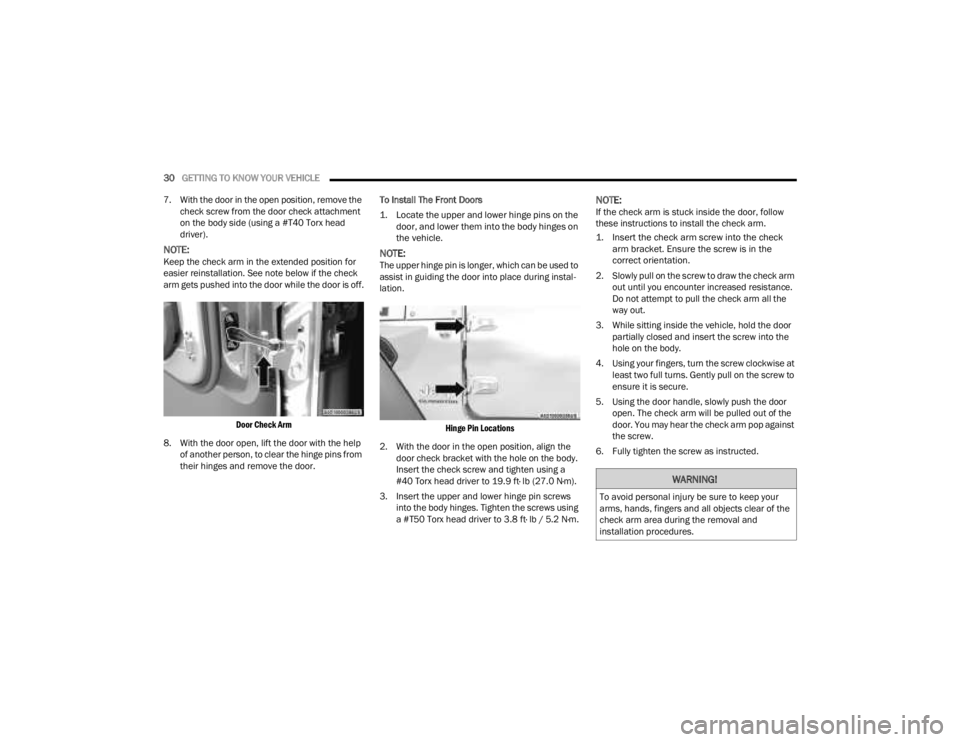
30GETTING TO KNOW YOUR VEHICLE
7. With the door in the open position, remove the check screw from the door check attachment
on the body side (using a #T40 Torx head
driver).
NOTE:Keep the check arm in the extended position for
easier reinstallation. See note below if the check
arm gets pushed into the door while the door is off.
Door Check Arm
8. With the door open, lift the door with the help of another person, to clear the hinge pins from
their hinges and remove the door. To Install The Front Doors
1. Locate the upper and lower hinge pins on the
door, and lower them into the body hinges on
the vehicle.
NOTE:The upper hinge pin is longer, which can be used to
assist in guiding the door into place during instal -
lation.
Hinge Pin Locations
2. With the door in the open position, align the door check bracket with the hole on the body.
Insert the check screw and tighten using a
#40 Torx head driver to 19.9 ft· lb (27.0 N·m).
3. Insert the upper and lower hinge pin screws into the body hinges. Tighten the screws using
a #T50 Torx head driver to 3.8 ft· lb / 5.2 N·m.
NOTE:If the check arm is stuck inside the door, follow
these instructions to install the check arm.
1. Insert the check arm screw into the check arm bracket. Ensure the screw is in the
correct orientation.
2. Slowly pull on the screw to draw the check arm out until you encounter increased resistance.
Do not attempt to pull the check arm all the
way out.
3. While sitting inside the vehicle, hold the door partially closed and insert the screw into the
hole on the body.
4. Using your fingers, turn the screw clockwise at least two full turns. Gently pull on the screw to
ensure it is secure.
5. Using the door handle, slowly push the door open. The check arm will be pulled out of the
door. You may hear the check arm pop against
the screw.
6. Fully tighten the screw as instructed.
WARNING!
To avoid personal injury be sure to keep your
arms, hands, fingers and all objects clear of the
check arm area during the removal and
installation procedures.
23_JT_OM_EN_USC_t.book Page 30
Page 34 of 448
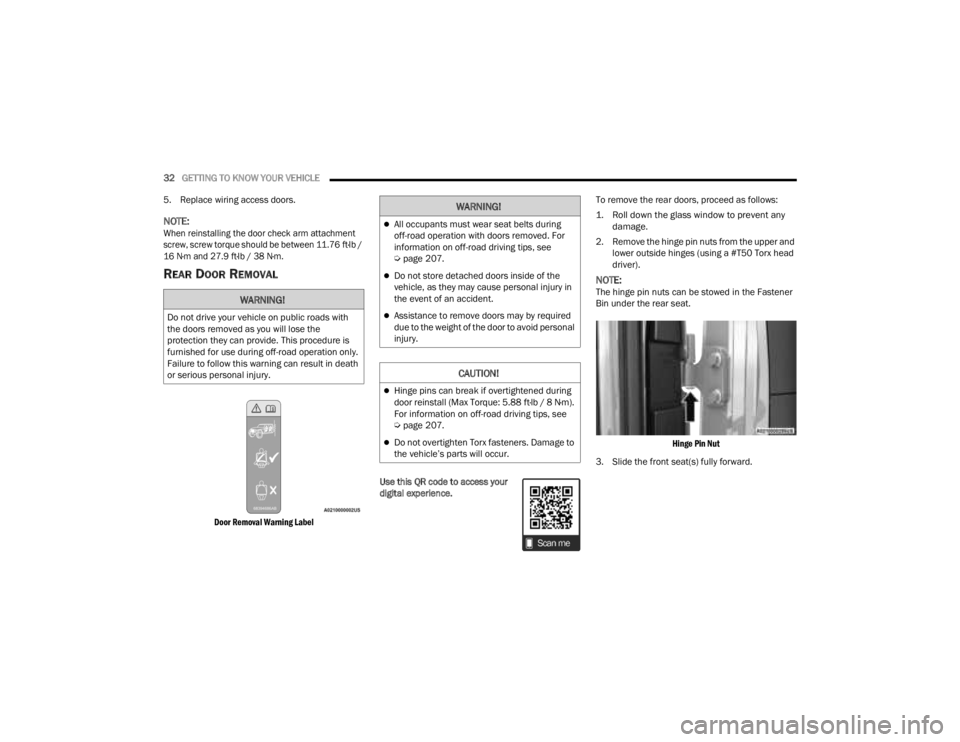
32GETTING TO KNOW YOUR VEHICLE
5. Replace wiring access doors.
NOTE:
When reinstalling the door check arm attachment
screw, screw torque should be between 11.76 ft·lb /
16 N·m and 27.9 ft·lb / 38 N·m.
REAR DOOR REMOVAL
Door Removal Warning Label
Use this QR code to access your
digital experience. To remove the rear doors, proceed as follows:
1. Roll down the glass window to prevent any
damage.
2. Remove the hinge pin nuts from the upper and lower outside hinges (using a #T50 Torx head
driver).
NOTE:The hinge pin nuts can be stowed in the Fastener
Bin under the rear seat.
Hinge Pin Nut
3. Slide the front seat(s) fully forward.WARNING!
Do not drive your vehicle on public roads with
the doors removed as you will lose the
protection they can provide. This procedure is
furnished for use during off-road operation only.
Failure to follow this warning can result in death
or serious personal injury.
WARNING!
All occupants must wear seat belts during
off-road operation with doors removed. For
information on off-road driving tips, see
Ú page 207.
Do not store detached doors inside of the
vehicle, as they may cause personal injury in
the event of an accident.
Assistance to remove doors may by required
due to the weight of the door to avoid personal
injury.
CAUTION!
Hinge pins can break if overtightened during
door reinstall (Max Torque: 5.88 ft·lb / 8 N·m).
For information on off-road driving tips, see
Úpage 207.
Do not overtighten Torx fasteners. Damage to
the vehicle’s parts will occur.
23_JT_OM_EN_USC_t.book Page 32
Page 35 of 448
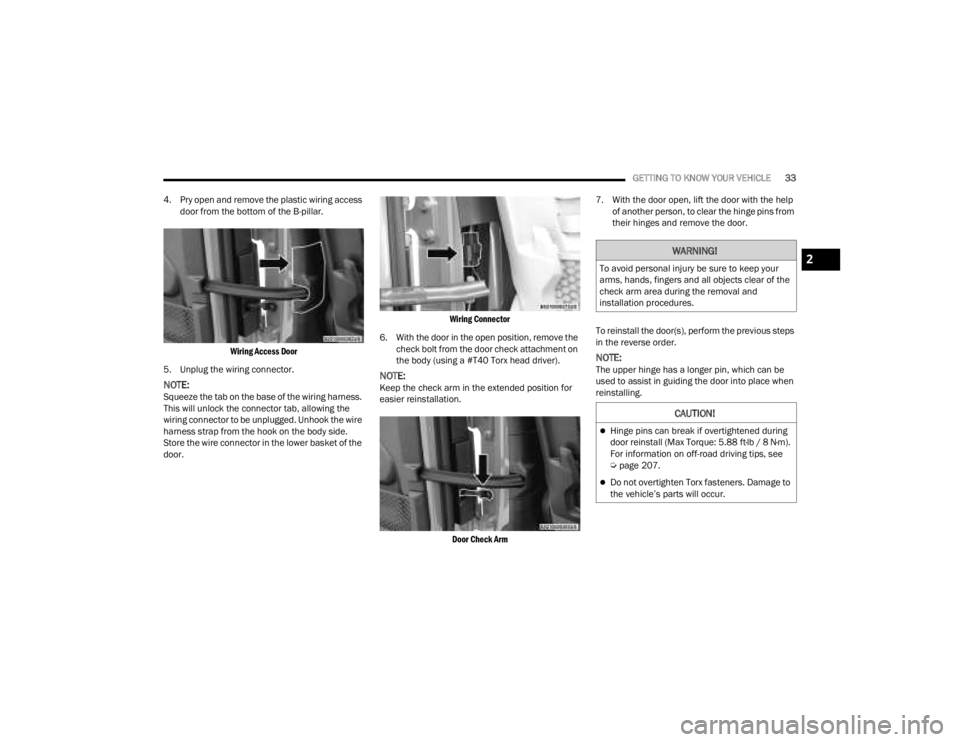
GETTING TO KNOW YOUR VEHICLE33
4. Pry open and remove the plastic wiring access door from the bottom of the B-pillar.
Wiring Access Door
5. Unplug the wiring connector.
NOTE:Squeeze the tab on the base of the wiring harness.
This will unlock the connector tab, allowing the
wiring connector to be unplugged. Unhook the wire
harness strap from the hook on the body side.
Store the wire connector in the lower basket of the
door.
Wiring Connector
6. With the door in the open position, remove the check bolt from the door check attachment on
the body (using a #T40 Torx head driver).
NOTE:Keep the check arm in the extended position for
easier reinstallation.
Door Check Arm
7. With the door open, lift the door with the help
of another person, to clear the hinge pins from
their hinges and remove the door.
To reinstall the door(s), perform the previous steps
in the reverse order.
NOTE:The upper hinge has a longer pin, which can be
used to assist in guiding the door into place when
reinstalling.
WARNING!
To avoid personal injury be sure to keep your
arms, hands, fingers and all objects clear of the
check arm area during the removal and
installation procedures.
CAUTION!
Hinge pins can break if overtightened during
door reinstall (Max Torque: 5.88 ft·lb / 8 N·m).
For information on off-road driving tips, see
Ú page 207.
Do not overtighten Torx fasteners. Damage to
the vehicle’s parts will occur.
2
23_JT_OM_EN_USC_t.book Page 33
Page 36 of 448
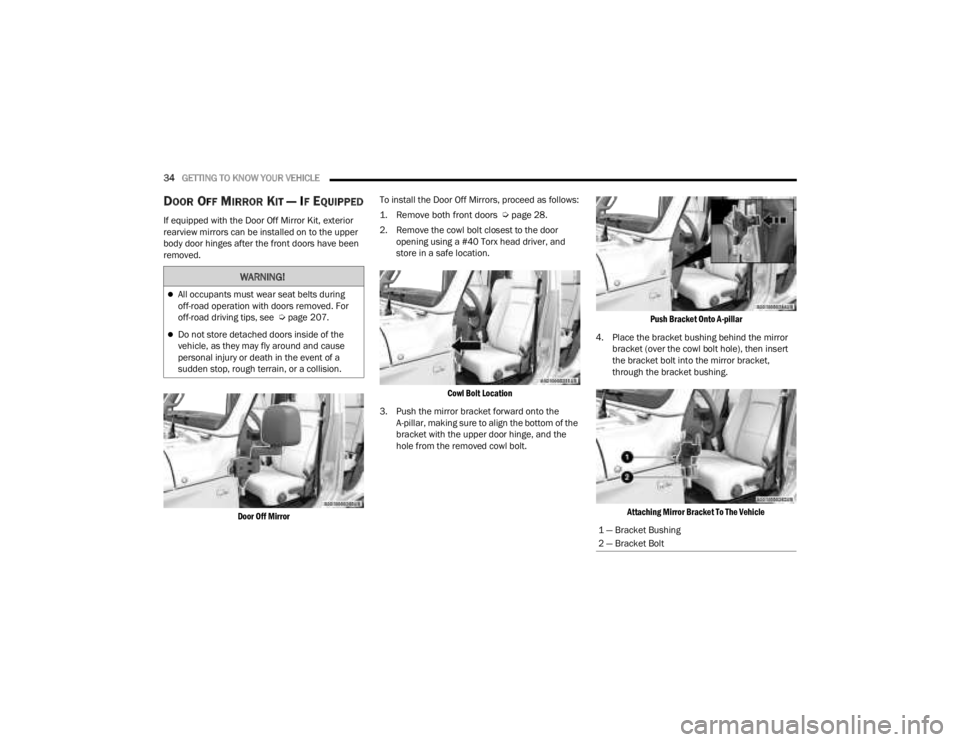
34GETTING TO KNOW YOUR VEHICLE
DOOR OFF MIRROR KIT — IF EQUIPPED
If equipped with the Door Off Mirror Kit, exterior
rearview mirrors can be installed on to the upper
body door hinges after the front doors have been
removed.
Door Off Mirror
To install the Door Off Mirrors, proceed as follows:
1. Remove both front doors
Ú
page 28.
2. Remove the cowl bolt closest to the door opening using a #40 Torx head driver, and
store in a safe location.
Cowl Bolt Location
3. Push the mirror bracket forward onto the A-pillar, making sure to align the bottom of the
bracket with the upper door hinge, and the
hole from the removed cowl bolt.
Push Bracket Onto A-pillar
4. Place the bracket bushing behind the mirror bracket (over the cowl bolt hole), then insert
the bracket bolt into the mirror bracket,
through the bracket bushing.
Attaching Mirror Bracket To The Vehicle
WARNING!
All occupants must wear seat belts during
off-road operation with doors removed. For
off-road driving tips, see Ú page 207.
Do not store detached doors inside of the
vehicle, as they may fly around and cause
personal injury or death in the event of a
sudden stop, rough terrain, or a collision.
1 — Bracket Bushing
2 — Bracket Bolt
23_JT_OM_EN_USC_t.book Page 34
Page 44 of 448
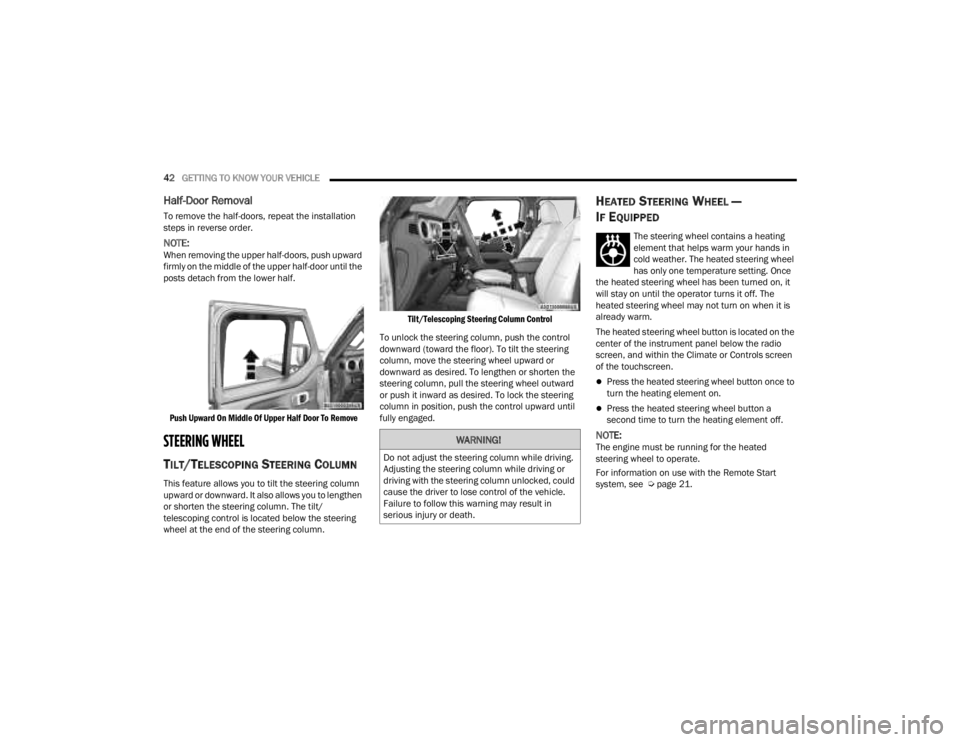
42GETTING TO KNOW YOUR VEHICLE
Half-Door Removal
To remove the half-doors, repeat the installation
steps in reverse order.
NOTE:When removing the upper half-doors, push upward
firmly on the middle of the upper half-door until the
posts detach from the lower half.
Push Upward On Middle Of Upper Half Door To Remove
STEERING WHEEL
TILT/TELESCOPING STEERING COLUMN
This feature allows you to tilt the steering column
upward or downward. It also allows you to lengthen
or shorten the steering column. The tilt/
telescoping control is located below the steering
wheel at the end of the steering column.
Tilt/Telescoping Steering Column Control
To unlock the steering column, push the control
downward (toward the floor). To tilt the steering
column, move the steering wheel upward or
downward as desired. To lengthen or shorten the
steering column, pull the steering wheel outward
or push it inward as desired. To lock the steering
column in position, push the control upward until
fully engaged.
HEATED STEERING WHEEL —
I
F EQUIPPED
The steering wheel contains a heating
element that helps warm your hands in
cold weather. The heated steering wheel
has only one temperature setting. Once
the heated steering wheel has been turned on, it
will stay on until the operator turns it off. The
heated steering wheel may not turn on when it is
already warm.
The heated steering wheel button is located on the
center of the instrument panel below the radio
screen, and within the Climate or Controls screen
of the touchscreen.
Press the heated steering wheel button once to
turn the heating element on.
Press the heated steering wheel button a
second time to turn the heating element off.
NOTE:The engine must be running for the heated
steering wheel to operate.
For information on use with the Remote Start
system, see Ú page 21.WARNING!
Do not adjust the steering column while driving.
Adjusting the steering column while driving or
driving with the steering column unlocked, could
cause the driver to lose control of the vehicle.
Failure to follow this warning may result in
serious injury or death.
23_JT_OM_EN_USC_t.book Page 42
Page 45 of 448
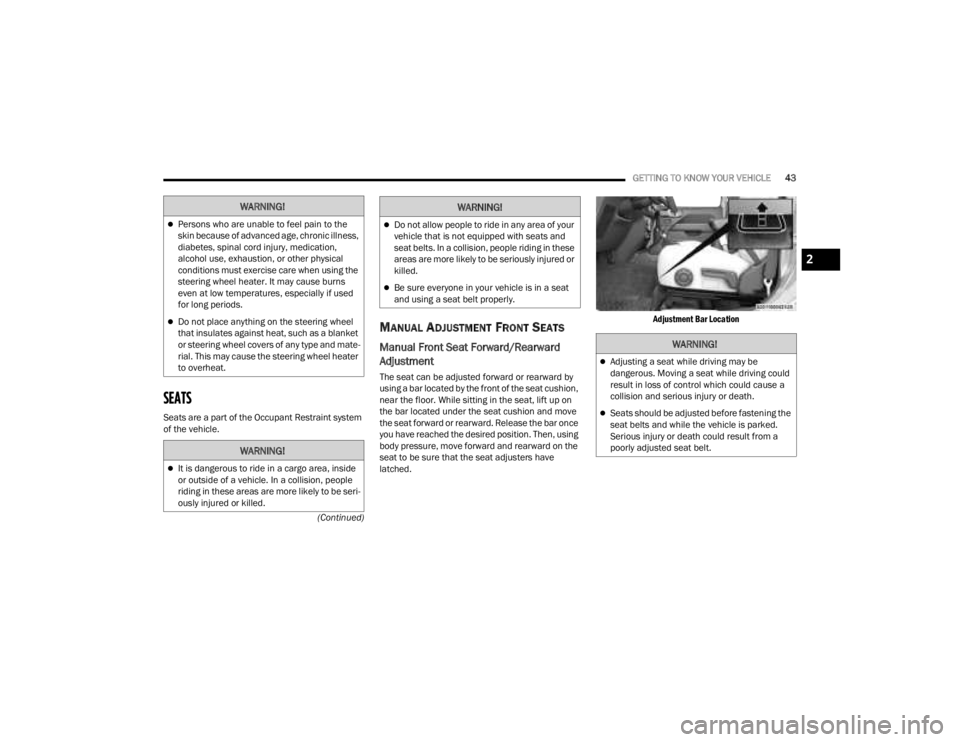
GETTING TO KNOW YOUR VEHICLE43
(Continued)
SEATS
Seats are a part of the Occupant Restraint system
of the vehicle.
MANUAL ADJUSTMENT FRONT SEATS
Manual Front Seat Forward/Rearward
Adjustment
The seat can be adjusted forward or rearward by
using a bar located by the front of the seat cushion,
near the floor. While sitting in the seat, lift up on
the bar located under the seat cushion and move
the seat forward or rearward. Release the bar once
you have reached the desired position. Then, using
body pressure, move forward and rearward on the
seat to be sure that the seat adjusters have
latched.
Adjustment Bar Location
WARNING!
Persons who are unable to feel pain to the
skin because of advanced age, chronic illness,
diabetes, spinal cord injury, medication,
alcohol use, exhaustion, or other physical
conditions must exercise care when using the
steering wheel heater. It may cause burns
even at low temperatures, especially if used
for long periods.
Do not place anything on the steering wheel
that insulates against heat, such as a blanket
or steering wheel covers of any type and mate
-
rial. This may cause the steering wheel heater
to overheat.
WARNING!
It is dangerous to ride in a cargo area, inside
or outside of a vehicle. In a collision, people
riding in these areas are more likely to be seri -
ously injured or killed.
Do not allow people to ride in any area of your
vehicle that is not equipped with seats and
seat belts. In a collision, people riding in these
areas are more likely to be seriously injured or
killed.
Be sure everyone in your vehicle is in a seat
and using a seat belt properly.
WARNING!
WARNING!
Adjusting a seat while driving may be
dangerous. Moving a seat while driving could
result in loss of control which could cause a
collision and serious injury or death.
Seats should be adjusted before fastening the
seat belts and while the vehicle is parked.
Serious injury or death could result from a
poorly adjusted seat belt.
2
23_JT_OM_EN_USC_t.book Page 43
Page 46 of 448
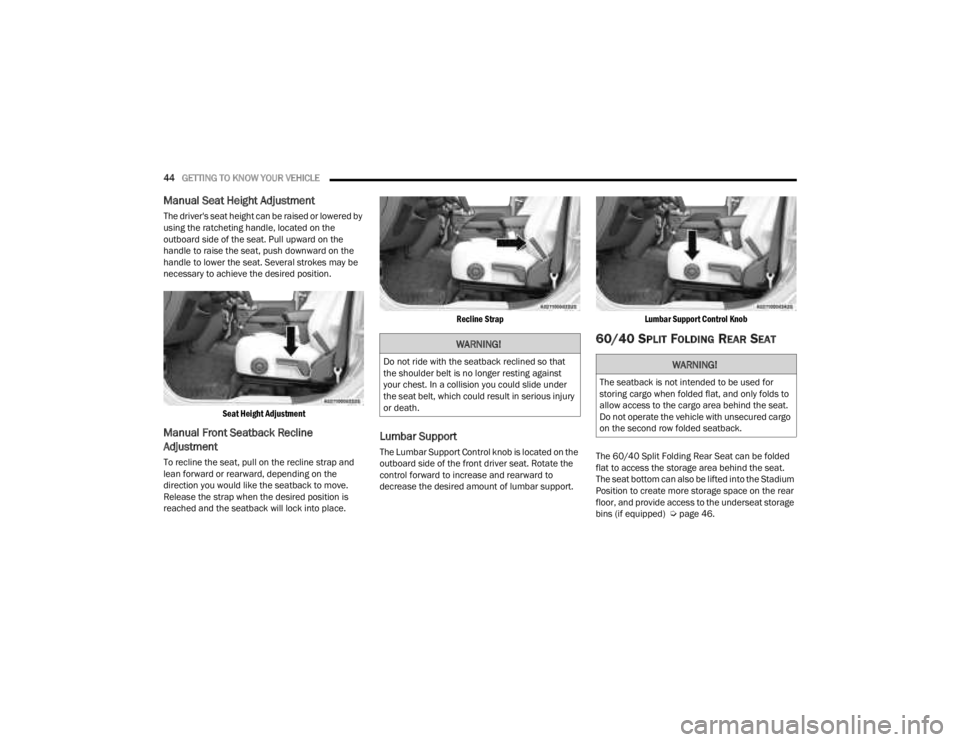
44GETTING TO KNOW YOUR VEHICLE
Manual Seat Height Adjustment
The driver's seat height can be raised or lowered by
using the ratcheting handle, located on the
outboard side of the seat. Pull upward on the
handle to raise the seat, push downward on the
handle to lower the seat. Several strokes may be
necessary to achieve the desired position.
Seat Height Adjustment
Manual Front Seatback Recline
Adjustment
To recline the seat, pull on the recline strap and
lean forward or rearward, depending on the
direction you would like the seatback to move.
Release the strap when the desired position is
reached and the seatback will lock into place.
Recline Strap
Lumbar Support
The Lumbar Support Control knob is located on the
outboard side of the front driver seat. Rotate the
control forward to increase and rearward to
decrease the desired amount of lumbar support.
Lumbar Support Control Knob
60/40 SPLIT FOLDING REAR SEAT
The 60/40 Split Folding Rear Seat can be folded
flat to access the storage area behind the seat.
The seat bottom can also be lifted into the Stadium
Position to create more storage space on the rear
floor, and provide access to the underseat storage
bins (if equipped) Ú
page 46.
WARNING!
Do not ride with the seatback reclined so that
the shoulder belt is no longer resting against
your chest. In a collision you could slide under
the seat belt, which could result in serious injury
or death.WARNING!
The seatback is not intended to be used for
storing cargo when folded flat, and only folds to
allow access to the cargo area behind the seat.
Do not operate the vehicle with unsecured cargo
on the second row folded seatback.
23_JT_OM_EN_USC_t.book Page 44
Page 47 of 448
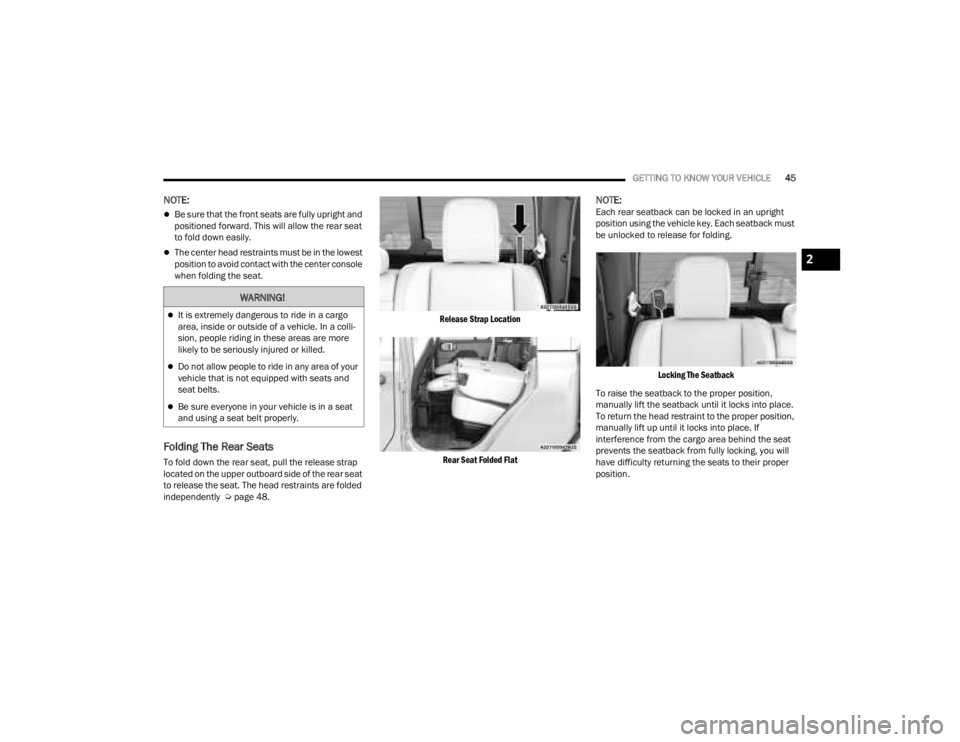
GETTING TO KNOW YOUR VEHICLE45
NOTE:
Be sure that the front seats are fully upright and
positioned forward. This will allow the rear seat
to fold down easily.
The center head restraints must be in the lowest
position to avoid contact with the center console
when folding the seat.
Folding The Rear Seats
To fold down the rear seat, pull the release strap
located on the upper outboard side of the rear seat
to release the seat. The head restraints are folded
independently Úpage 48.
Release Strap Location
Rear Seat Folded Flat
NOTE:Each rear seatback can be locked in an upright
position using the vehicle key. Each seatback must
be unlocked to release for folding.
Locking The Seatback
To raise the seatback to the proper position,
manually lift the seatback until it locks into place.
To return the head restraint to the proper position,
manually lift up until it locks into place. If
interference from the cargo area behind the seat
prevents the seatback from fully locking, you will
have difficulty returning the seats to their proper
position.
WARNING!
It is extremely dangerous to ride in a cargo
area, inside or outside of a vehicle. In a colli -
sion, people riding in these areas are more
likely to be seriously injured or killed.
Do not allow people to ride in any area of your
vehicle that is not equipped with seats and
seat belts.
Be sure everyone in your vehicle is in a seat
and using a seat belt properly.
2
23_JT_OM_EN_USC_t.book Page 45
Page 48 of 448
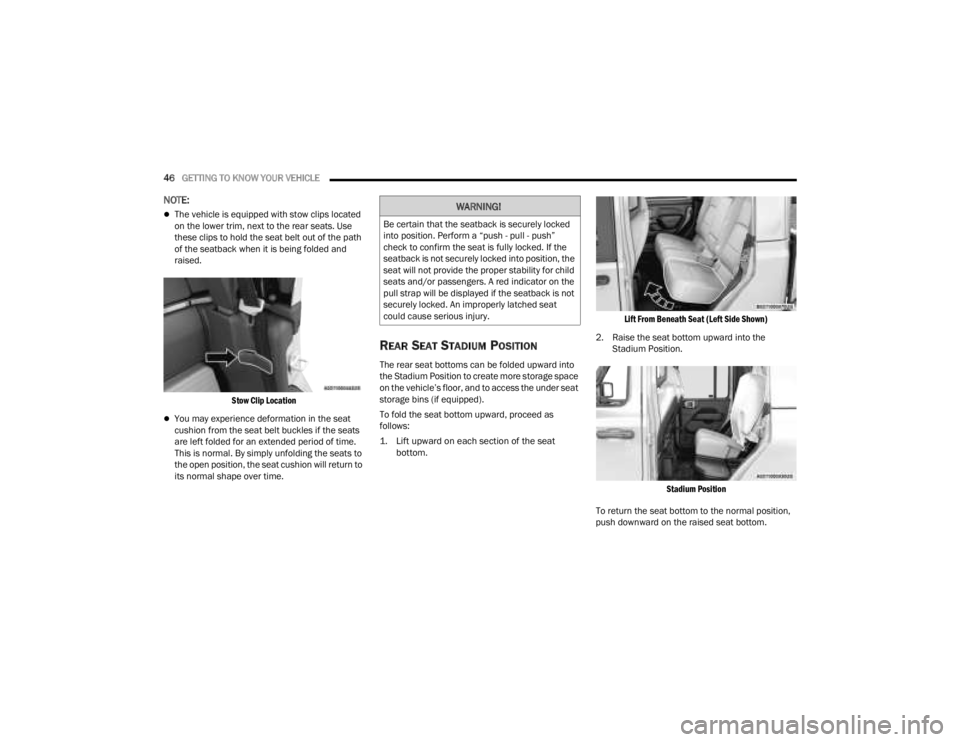
46GETTING TO KNOW YOUR VEHICLE
NOTE:
The vehicle is equipped with stow clips located
on the lower trim, next to the rear seats. Use
these clips to hold the seat belt out of the path
of the seatback when it is being folded and
raised.
Stow Clip Location
You may experience deformation in the seat
cushion from the seat belt buckles if the seats
are left folded for an extended period of time.
This is normal. By simply unfolding the seats to
the open position, the seat cushion will return to
its normal shape over time.
REAR SEAT STADIUM POSITION
The rear seat bottoms can be folded upward into
the Stadium Position to create more storage space
on the vehicle’s floor, and to access the under seat
storage bins (if equipped).
To fold the seat bottom upward, proceed as
follows:
1. Lift upward on each section of the seat bottom.
Lift From Beneath Seat (Left Side Shown)
2. Raise the seat bottom upward into the Stadium Position.
Stadium Position
To return the seat bottom to the normal position,
push downward on the raised seat bottom.
WARNING!
Be certain that the seatback is securely locked
into position. Perform a “push - pull - push”
check to confirm the seat is fully locked. If the
seatback is not securely locked into position, the
seat will not provide the proper stability for child
seats and/or passengers. A red indicator on the
pull strap will be displayed if the seatback is not
securely locked. An improperly latched seat
could cause serious injury.
23_JT_OM_EN_USC_t.book Page 46
Page 49 of 448
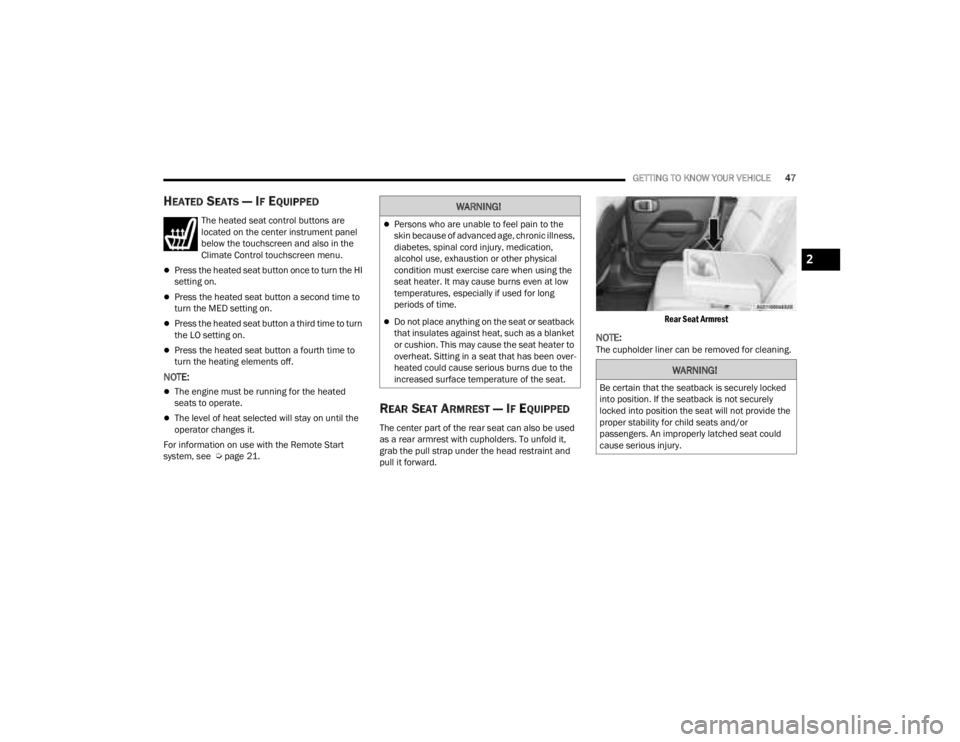
GETTING TO KNOW YOUR VEHICLE47
HEATED SEATS — IF EQUIPPED
The heated seat control buttons are
located on the center instrument panel
below the touchscreen and also in the
Climate Control touchscreen menu.
Press the heated seat button once to turn the HI
setting on.
Press the heated seat button a second time to
turn the MED setting on.
Press the heated seat button a third time to turn
the LO setting on.
Press the heated seat button a fourth time to
turn the heating elements off.
NOTE:
The engine must be running for the heated
seats to operate.
The level of heat selected will stay on until the
operator changes it.
For information on use with the Remote Start
system, see Ú page 21.REAR SEAT ARMREST — IF EQUIPPED
The center part of the rear seat can also be used
as a rear armrest with cupholders. To unfold it,
grab the pull strap under the head restraint and
pull it forward.
Rear Seat Armrest
NOTE:The cupholder liner can be removed for cleaning.
WARNING!
Persons who are unable to feel pain to the
skin because of advanced age, chronic illness,
diabetes, spinal cord injury, medication,
alcohol use, exhaustion or other physical
condition must exercise care when using the
seat heater. It may cause burns even at low
temperatures, especially if used for long
periods of time.
Do not place anything on the seat or seatback
that insulates against heat, such as a blanket
or cushion. This may cause the seat heater to
overheat. Sitting in a seat that has been over
-
heated could cause serious burns due to the
increased surface temperature of the seat.
WARNING!
Be certain that the seatback is securely locked
into position. If the seatback is not securely
locked into position the seat will not provide the
proper stability for child seats and/or
passengers. An improperly latched seat could
cause serious injury.
2
23_JT_OM_EN_USC_t.book Page 47